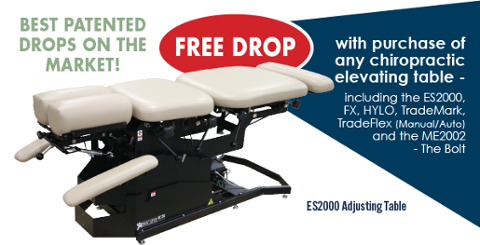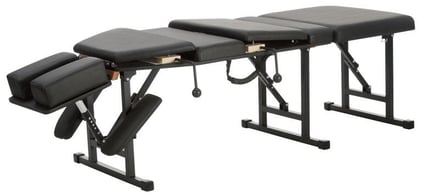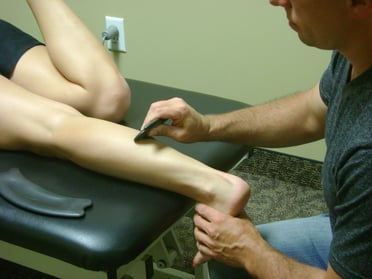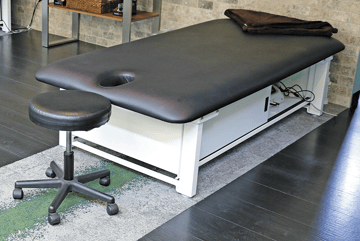Patients turn to us when they have musculoskeletal disorders—but unless we take care, we can be at risk for the same injuries that we’re treating. Lauriann Greene, CEAS; Richard W. Goggins, CPE, LMP; and Jennifer Hess, DC, MPH, PhD, explain how the right table, tools and postures can make a huge difference in preventing work-related injuries.
Chiropractors share an irony with many health care practitioners – the physical demands of their work place them at risk for the same musculoskeletal disorders (MSDs) that they treat in their patients. For some, the first injury occurs before their careers even begin. Students in chiropractic college can suffer upper extremity injuries from repetitive adjusting techniques performed before they have the necessary endurance to handle the workload or the experience to use techniques thatrequire the minimum amount of effort.1 Students may also suffer from spinal injuries when receiving adjustments from their equally inexperienced classmates.2 Unfortunately, a prior musculoskeletal injury is one of the strongest predictors of future injury.3 As a result, some chiropractors may begin their careers predisposed to the same types of injuries that they have just been trained to treat.
|
PHS Chiropractic's Basic Pro Potable Table |
An elevated risk for injury appears to continue through the first five years of practice, also likely due to a relative lack of experience. The most common sites of injury that practitioners report are the wrist and hand, shoulder and low back.4 Adjusting the thoracic and lumbosacral spine, particularly when the patient is side-lying, is associated with an increased risk of injury.4 It is interesting to note that occupational MSDs in health care occur not because of an isolated event like an accident but instead as a result of activities that are a regular part of the job.
This is not to imply that work is the sole cause of these injuries. Off-work activities can expose manual practitioners to some of the same types of injury risk factors – forceful exertions, awkward postures and repetitive motions – that work can. Personal risk factors such as age, physical condition and even emotional well-being can all help determine our susceptibility to injury. 3
If MSDs result from a number of different risk factors, including everyday work activities, then what can you do to prevent them? A comprehensive approach to identifying and eliminating or reducing risk factors at work and off work, along with maintaining good physical and emotional health, is likely to be the most effective tactic. A key element in this approach is applying the principles of ergonomics to your practice.

As practitioners, you are probably already familiar with the concept of ergonomics – fitting the job to the worker – and you may even counsel your patients on ways they can use ergonomics in their work. But have you taken the time to apply these same concepts to your own work?
One straightforward example of ergonomics in a chiropractic practice is adjusting table height to reduce awkward bending postures while performing adjusting techniques on a patient’s spine. A low table height, around 18 inches (465 mm), will result in greater muscle effort to support your upper body weight as you lean forward, as well as greater stress on ligaments and higher compressing forces on intervertebral discs. Depending on your height, a medium table height closer to 26 inches (665 mm) may be appropriate for prone adjusting techniques working on the lumbar and thoracic regions, since this height still allows you to use the weight of your upper body to assist with the adjustment, but does not require excessive forward bending. A higher table, around 33 inches (845 mm) high, may be more appropriate for prone cervical work, where less force is required.5
|
Via Dr. Jerad Bludorn, DC and PHS Chiropractic |
It seems intuitively obvious that table height can make a big difference in the postures that practitioners must assume when working, but do you always take the time to adjust your table to best possible position? For that matter, do you have a hi-lo table that you can easily adjust for working on different parts of the spine, using different techniques or even accommodating different patients? A power-adjustable table may be one of the best investments you can make in your own ergonomics, particularly since up to almost 50 percent of the purchase cost of a hi-lo table may qualify for an ADA tax credit. In addition to an optimum table height, it’s also important to have adequate space so that you can work on both sides of the table, and to take the time to move from one side to the other. We all have our preferred side on which to work, but changing sides distributes the work and reduces physical stress on the upper extremity, trunk and lower extremity.
Maintaining good body mechanics is also important for preventing MSDs. While we teach our patients the tenants of good body mechanics, we sometimes don’t apply these rules to ourselves. Be sure to maintain neutral spine and upper extremity postures, whether you are working around your chiropractic table, adjusting extremities, instructing patients in rehabilitation techniques or working on your computer.
An ergonomic treatment room set-up is a necessary first step toward good body mechanics. But good ergonomics and good body mechanics are not sufficient to ensure a career free of injury. Even with the best possible set up and attention to body mechanics, it is still possible to suffer an injury due to repetition and overuse. Leaving enough time in your schedule for rest and recovery during the day, the week and over the course of the year can help you to not only avoid injury, but also have theenergy left to give your last patient of the day the same level of treatment as the first.
|
via PHS Chiropractic |
You may notice that you use more physical effort in treating some patients than others, either due to their size or the techniques that you use. You might consider arranging your schedule so that you see physically demanding patients during the time of day when you typically feel at your physical peak. Scheduling patients who require less demanding treatments on either side of these more challenging patients may also help you avoid overloading yourself.
Practicing a variety of modalities is also a good way to avoid injury due to overuse. Certain techniques can place physical demands both on the practitioner and on the patient. Incorporating other techniques and tools could help expand your practice and prolong your career. Investigate tools and techniques that you can use for soft tissue work as well, since soft tissue work is a common cause of upper extremity MSDs.
Consider applying these principles of ergonomics not only to your own work, but also to the work of your office staff and any other practitioners that you employ, particularly massage therapists (who have been shown to experience high rates of MSDs as a result of their work).6 Your staff will love you for it, and your patients will receive better treatment as a result
A good ergonomics program should be the cornerstone of your self-care program. Following the same advice that you give your patients to help them stay well offers you the best chance to prevent work-related musculoskeletal injuries.

Sources
- Bisiacchi D, Huber L (2006). Physical injury assessment of male versus female chiropractic students when learning and performing adjustive techniques: a preliminary investigative study. Chiropractic and Osteopathy; 14:17.
- Macaunuel K, Deconnick A; et al. (2005) Characterization of side effects sustained by chiropractic students during their undergraduate training in technique class at a chiropractic college: a preliminary retrospective study. Journal of Canadian Chiropractic Association; 49(1):46-55.
- National Research Council (2001). Musculoskeletal Disorders and the Workplace: Low Back and Upper Extremities. National Academies Press, Washington, D.C.
- Holm SM, Rose KR (2006). Musculoskeletal injuries in chiropractors. Journal of chiropractic education, 20(1):22-3.

- Lorme KJ, Naqvi SA (2003). Comparative analysis of low-back loading on chiropractors using various workstation table heights and performing various tasks. Journal of Manipulative Physiological Therapy, Jan. 26(1): 25-33.
- Greene L, Goggins RW (2006). Musculoskeletal symptoms and injuries among experienced massage and bodywork professionals. Massage & Bodywork; Dec-Jan: 48-58.
Lauriann Greene, CEAS and Richard W. Goggins, CPE, LMP are co-authors of Save Your Hands! The Complete Guide to Injury Prevention and Ergonomics for Manual Therapists, 2nd Edition, the leading self-care text for manual therapists since 1995. Trained as a massage therapist, Lauriann is now a Certified Ergonomics Assessment Specialist and has been a leading writer and educator on this subject for over 15 years. Richard is a Board-Certified Professional Ergonomist, and has spent nearly 20 years working with business owners and employees to prevent injuries in a wide variety of industries. Lauriann and Richard now offer ergonomics consulting, training and continuing education programs to manual therapists and the companies that employ them. For more information, visit www.saveyourhands.com.
Jennifer Hess, DC, MPH, PhD is a research associate and ergonomist at the Labor Education and Research Center (LERC) of the University of Oregon. She received her Ph.D. from the University of Oregon in the Department of Human Physiology (2004). Prior to coming to the University of Oregon, Hess maintained a full time chiropractic practice emphasizing ergonomics, injury prevention and musculoskeletal rehabilitation.




